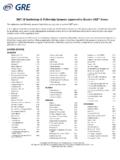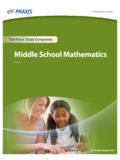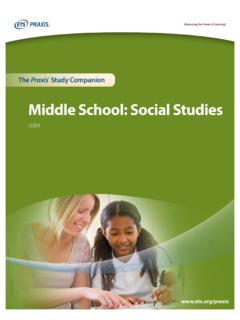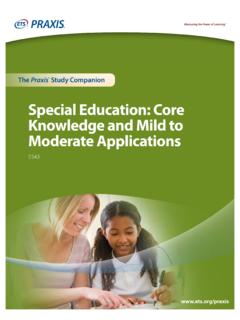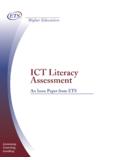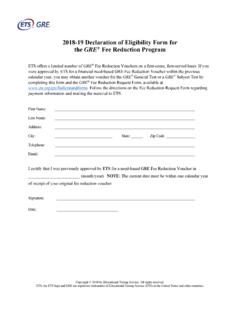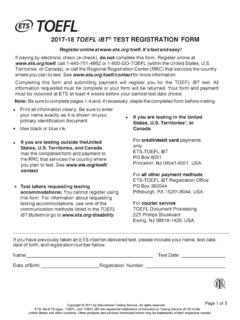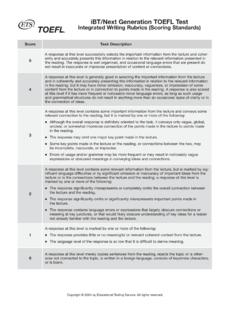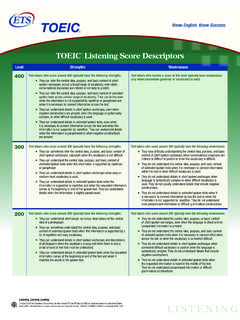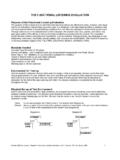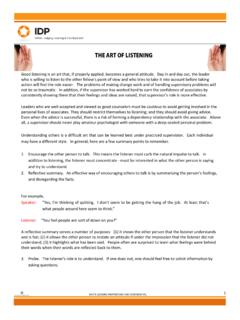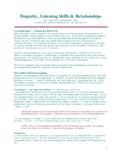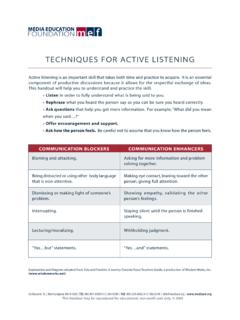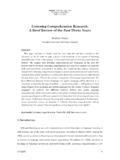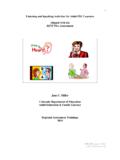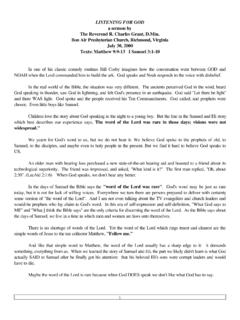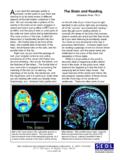Transcription of Can-Do Guide Executive Summary - ETS Home
1 Can-Do GuideExecutive SummaryLISTENING & READING(IBC)The Redesigned TOEIC ( listening and Reading) Test: Relations to Test-Taker Perceptions of Proficiency in EnglishDonald E. Powers, Hae-Jin Kim, and Vincent Z. Weng Princeton, NJ, ETSN ovember 2008 Table of Contents Abstract .. 1 Executive Summary .. 2 The Redesigned TOEIC ( listening and Reading) Test: Relations to Test-Taker Perceptions of Proficiency in English ..3 Method .. 3 Results .. 4 Table 1: Correlations Among Can-Do Self-Assessments and TOEIC Scores .. 5 Table 2: Percentages of TOEIC Test Takers, by listening Score Level, Who Indicated That They Could Perform Various English-Language listening Tasks Either Easily or With Little Difficulty .. 6 Table 3: Percentages of TOEIC Test Takers, by Reading Score Level, Who Indicated That They Could Perform Various English-Language Reading Tasks Either Easily or With Little Difficulty.
2 8 Using the Can-Do Tables .. 10 Discussion/Implications .. 11 References .. 12 TOEIC Can-Do Guide 1To facilitate the interpretation of test scores from the redesigned TOEIC ( listening and reading) test as a measure of English language proficiency, we administered a self-assessment inventory to TOEIC examinees in Japan and Korea that gathered perceptions of their ability to perform a variety of everyday English language tasks. TOEIC scores related relatively strongly to test-taker self-reports for both reading and listening tasks. The results were, with few exceptions, extraordinarily consistent, with examinees at each higher TOEIC score level being more likely to report that they could successfully accomplish each of the everyday language tasks in English. The pattern of correlations also showed modest discriminant validity of the listening and reading components of the redesigned TOEIC, suggesting that both sections contribute to the measurement of English language Test of English for International Communications (TOEIC ) assessment was developed to measure the ability to listen and read in English, using a variety of contexts from real-world settings.
3 Recently, a revision of the test was undertaken, in order to better align test questions with everyday workplace language scenarios and to provide test takers with more information about their listening and reading proficiency levels. Although many of the question types are the same as in the previous version of the TOEIC ( listening and reading) test, there are some significant modifications. These modifications were undertaken in order to articulate more exactly various aspects of the construct. Specifically, the listening section now has: fewer questions that involve photographs, both recorded and written questions to assess understanding of conversations and short talks, fewer individual questions and more sets of questions to assess the understanding of conversations, and a range of different English accents, as spoken in the United States, Great Britain, Canada, and Australia.
4 The new reading section has the following major changes: the elimination of questions that require the recognition of grammatical errors, the addition of text completion questions, an increase in the number of reading comprehension questions, and the inclusion of sets of questions based on two interrelated passages. In Summary , these changes are intended to align the test more closely with theories of communicative competence (see, for example, Bejar, Douglas, Jamieson, Nissan, & Turner, 2000; Enright, Grabe, Koda, Mosenthal, Mulcahy-Ernt, et al., 2000). For instance, the use of interrelated passages now actually requires the use of strategies to comprehend and connect information in order to answer some of the questions. In addition, the redesigned TOEIC test is believed to better reflect international business communication styles and real language contexts.
5 The revision is thought to be a valid measure of international communication today. The effort described here was intended to provide evidence of the validity of the revised TOEIC ( listening and reading) test as a measure of English language proficiency. We hoped to accomplish this by establishing the relationship between scores on the redesigned TOEIC test and test-taker reports of their ability to perform selected, everyday language tasks in English. Executive SummaryTOEIC Can-Do Guide 3 The Redesigned TOEIC ( listening and Reading) Test: Relations to Test-Taker Perceptions of Proficiency in EnglishMethodIn order to accomplish our objective, we assembled and administered (in the summer of 2007) a self-report Can-Do inventory to TOEIC test takers in Japan and Korea immediately after they had taken the test. The inventory included a series of common-language tasks ( Can-Do statements) for both listening (24 tasks) and reading (25 tasks).
6 Tasks were adapted from previous studies ( , Duke, Kao, & Vale, 2004; Powers, Roever, Huff, & Trapani, 2003; Tannenbaum, Rosenfeld, Breyer, & Wilson, 2007). Tasks were translated from English into Japanese and Korean (and also back-translated), so as to convey, to the extent possible, the same meaning as the original text. The translations were performed by ETS field representatives in Japan and Korea, with subsequent reviews provided by ETS staff and an external consultant. Directions, which were also translated into Japanese and Korean, were as follows: Below you will find several statements about English-language listening and reading activities. For each statement, please circle the one number that you believe best represents your ability to perform the activity in English. If you have never actually performed the activity that is described, please rate how easily you believe you could perform the activity if you had to do so in English.
7 Test takers were asked to respond to each statement using a 5-point scale, with responses as follows: 1 = not at all, 2 = with great difficulty, 3 = with some difficulty, 4 = with little difficulty, and 5 = easily. Respondents were allowed to omit a task statement if they felt that it did not apply to them or if they were unable to make a judgment. Two putatively parallel forms of the inventory were assembled, each with approximately half of the Can-Do statements. Both the test and the inventory were administered via computer, with each form of the inventory administered to a random half of the total examinees. scores and Can-Do reports were obtained from 7,292 test takers from Japan and 3,626 from Korea. Nearly 5,400 participants completed one form of the inventory, and approximately 5,500 completed the other form. Table 1 shows the correlations between each TOEIC listening and reading score and test takers assessments of their ability to perform the Can-Do tasks, as defined by the sum of responses to (a) all listening Can-Do tasks and (b) all reading Can-Do tasks.
8 For both of the listening Can-Do forms, the Cronbach alpha reliability estimate was .94. For the reading Can-Do forms, these estimates were .95 and .94. For the TOEIC scores, the KR20 reliability estimates were .93 for reading scores and .92 for listening scores. As can be seen from Table 1, the correlations between TOEIC listening and reading scores are high (.80 for the sample taking one form of the inventory and .81 for those taking the other form), as are the correlations between the listening and reading Can-Do reports (.80 for one form and .77 for the other). Can-Do listening reports and TOEIC listening scores correlate relatively strongly (.53 for each form). The corresponding correlation between reading Can-Do reports and TOEIC reading scores is only slightly lower (.47 and .48). (Individually, the correlations of reading statements with TOEIC reading scores range from.)
9 08 to .48, with a median of .39. For listening statements, the correlations range from .30 to .50, with a median of .44.) The correlations between reading Can-Do reports and TOEIC listening scores (.47 and .46), and between listening Can-Do reports and TOEIC reading scores (.43 and .45), are slightly lower, thus suggesting some discriminant validity of the two TOEIC scores, even though they correlate highly with one another, as do the listening and reading Can-Do reports. This result is confirmed when correlations are corrected for attenuation, as the correlation between TOEIC listening and reading scores is estimated to be very high (.86 to .88), but not perfect. The same is true for the listening and reading Can-Do reports, whose disattenuated correlations are .82 to .85. The effect of disattenuating the correlations between Can-Do reports and TOEIC scores was to increase the correlations systematically, by.
10 03 to .04. To allow a better indication of how test performance relates to each Can-Do activity individually, we have also presented (in Table 2 for listening and Table 3 for reading) item-by-item results, ordered by the degree of difficulty of each Can-Do task (mean response on the 5-point scale). Because the samples that completed the two Can-Do forms were randomly equivalent, we have merged the results into two tables one for listening and one for reading. The percentages shown are the proportions of test takers at each of several score intervals who said that they could perform the task either easily or with little difficulty. An arbitrary TOEIC score range of 55 points was chosen for each interval, except for the lowest one. For this lowest interval, a range of 130 points was used because there were very few test takers in this lowest score range and the percentages would have been extremely unstable with any fewer test takers.
